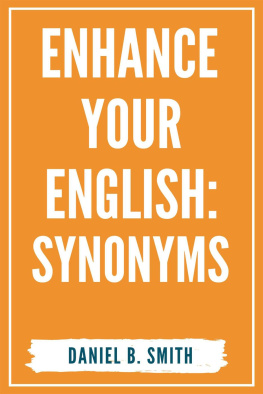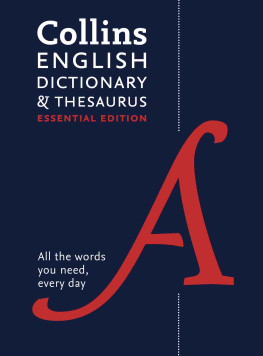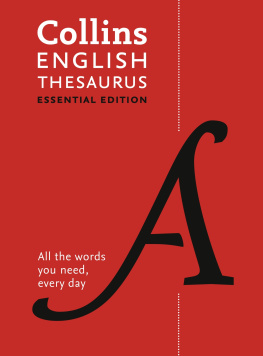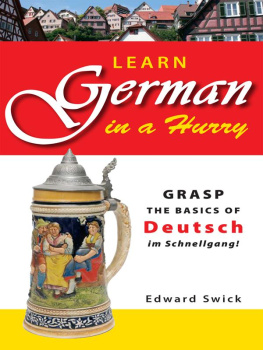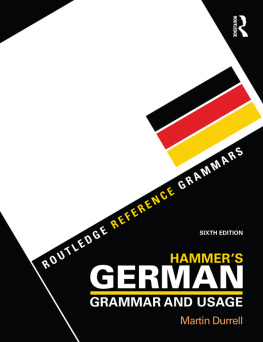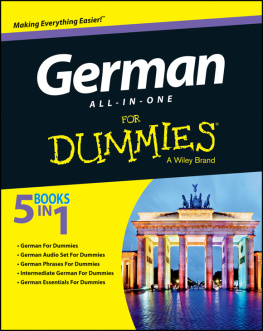PREFACE
This work has grown out of my experience of university teaching. As the inability of students to use words correctly impressed itself upon me more and more, I came to see that this was due in the first place to the immense difficulties inherent in the study of words, and in the second to the complete lack of adequate dictionaries, whether English-German or entirely German, and of other reference-works such as Fowlers Modern English Usage. Dictionaries such as Eberhards Synonymisches Worterbuch, incidentally out of print for many years, have their uses, but are insufficient for the needs of the English-speaking learner in that their explanations, naturally enough, do not take into account his special difficulties. The present work represents a new departure in taking as the starting point of each article the difficult English word or group of words and in proceeding on this basis to explain the German terms. With its help a systematic study of words and, ultimately, a more sensitive feeling for their values should be possible both at school and at university level.
Only common difficult words, and within this restricted scope rarely the names of concrete objects, have been treated, i. e. principally those English terms which in each of their senses require to be translated by a number of German terms. The fact that German lacks terms of such wide application as take, way, leave, keep, power (to mention only a few of the more notorious), and must therefore use specific terms, perhaps to a greater extent than even French, is an indication of what is here attempted. The English word is taken singly or in a group. In a few cases, where the magnitude of the difficulty seemed to call for it, a further explanation has been attached in brackets to the examples. Footnotes which extend the group or refer to related terms liable to be confused have also been added in order to inculcate in the student the habit of examining words in groups. Such notes are in the form of hints designed to open up fresh avenues of investigation; they are not exhaustive explanations. In the arrangement of any group of English words the most general term is usually placed first. The meanings and shades of meaning of the English word become clear through the explanation of the German term. Only in a few cases was it thought necessary to give a special explanation of the former. Sometimes the divisions are made on the basis of the meanings of the English word or words (occasionally taken from the Oxford dictionaries), so that the same German term may appear more than once in the same article. In other cases the German words themselves form the divisions, and so explain by implication the various meanings of the English. The explanations, which differ in their degree of fullness, concentrate on normal prose usage of today, but point out usage in poetry and elevated prose diction as well as obsolete uses (e. g. with Gemiit and Sinn). They also draw attention to a few errors made by Germans (e. g. scheinbar for anscheinend). Grammatical constructions have been treated
only in rare cases where their understanding is indispensable for the correct use of a word. References are given to such works as the Shorter Oxford Dictionary, the Pocket Oxford Dictionary (referred to as S. O. D. and P. O. D. respectively), to Websters Dictionary of Synonyms and Fowlers Modern English Usage, where they seem necessary or particularly helpful.
The work is addressed primarily to students and teachers, but I venture to think that parts of it will not be without interest to lexicographers. My warmest thanks are due to the following for their generous help, not only in discussing the examples, but in criticizing the explanations: the late Dr V. Stadler (former lecturer in German in the University of Sydney), Dr K. von Stutterheim (his successor), and Mr A. Scheidt.
R. B. FARRELL
PREFACE TO THE SECOND EDITION
The reception accorded the first version of this work and the requests that it be enlarged. have prompted this revised and expanded version. This adheres to the same general principle of taking as the point of departure the English term which must be variously translated into German. In treating new English words, however, I have begun by giving more often than in the first version their specific meanings as defined by Webster, the Shorter Oxford, sometimes the Concise Oxford or the Advanced Learners Dictionary of Current English, and it has not infrequently turned out that the specific sense of the English word is the definition of the German. By this method, it seemed to me, students would be encouraged more often than at present appears to be the case, to consult the English dictionary before choosing a German word. A good number of the examples of the German term, moreover, are simply translations of the examples of the word in question given in the English dictionaries. Not all uses of the English term, however, have been treated, particularly when these are technical, since such uses are listed in the ordinary English-German dictionaries and present no difficulty. For example, under standard I have not given standard lamp ( Stehlampe ). A new feature of this edition is the inclusion of terms used for objects, which was a notable gap in the first version. Revision of the first version with a view to improving some of the examples and the explanations is a further feature of the present one. Since the first version, Dudens Vergleichendes Synonym-Wrterbuch (1964) has appeared and sheds light on a number of difficulties. It does not, however, by any means treat all the difficulties that arise for the English-speaking student of German and so does not make the present work superfluous.


